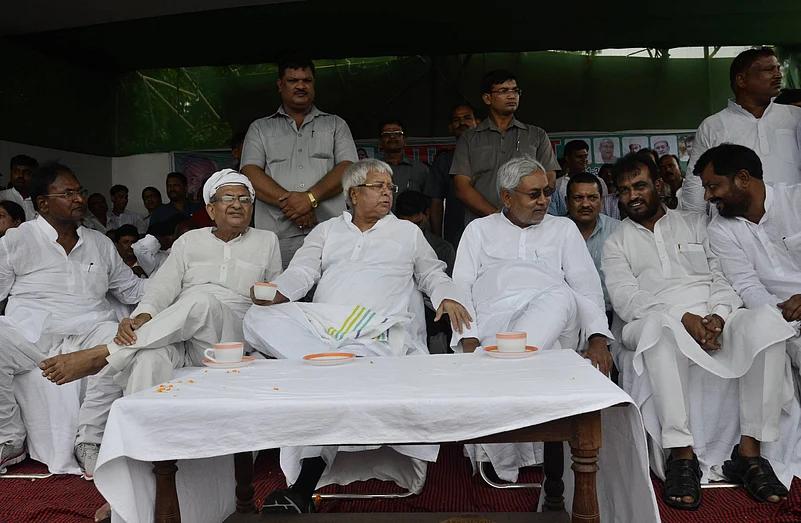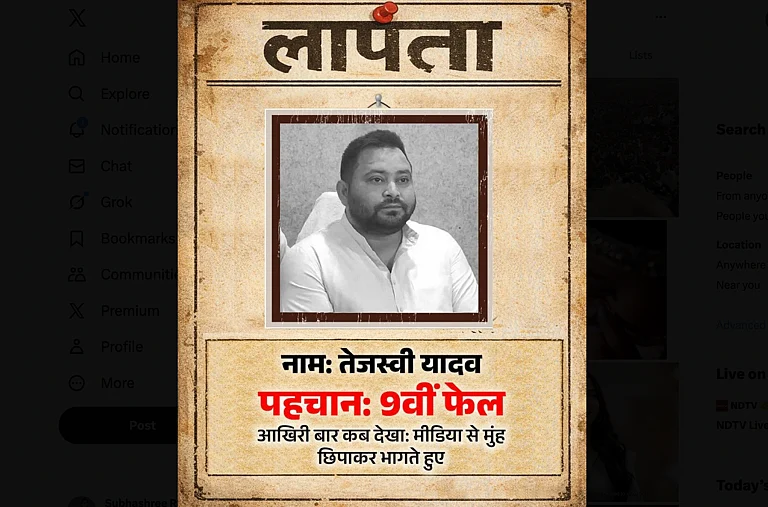
From Bhola Paswan Shastri’s Dalit milestone and Karpoori Thakur’s OBC reforms to Lalu Prasad Yadav’s Mandal-era populism, caste empowerment has defined Bihar’s politics, often at the cost of governance.
Since the 1968 Congress split, Bihar has witnessed chronic political flux, marked by frequent defections
Nitish Kumar’s reformist drive revived infrastructure and welfare delivery post-2005, but shifting alliances and persistent inequality show Bihar’s struggle
Bihar’s political journey since 1968 has been marked by turmoil, caste conflicts, and the lasting imprints of its chief ministers. The imposition of President’s Rule that year, following years of Congress infighting after the death of Sri Krishna Sinha in 1961, signaled the start of an era of unstable coalitions and shifting loyalties.
From Bhola Paswan Shastri’s brief but historic tenure as Bihar’s first Dalit chief minister to Lalu Prasad Yadav’s populist yet polarizing rule, and from Nitish Kumar’s reform-driven governance to the fleeting administrations of leaders like Harihar Singh and Jitan Ram Manjhi, each has shaped the state’s destiny in times of poverty, violence, and rising social justice movements. Together, they trace the story of a state perpetually balancing between progress and division.
The 1968 Crisis and a Fractured Congress
The late 1960s plunged Bihar into political chaos following the death of Congress stalwart Sri Krishna Sinha. His successors, Binodanand Jha (1961–63) and K.B. Sahay (1963–67), struggled to manage a Congress divided by upper-caste rivalries among Brahmins, Bhumihars, and Rajputs. Regional parties like the Samyukta Socialist Party (SSP) and Bharatiya Kranti Dal gained ground in Patna and Muzaffarpur, capitalizing on the party’s internal fractures. On January 29, 1968, Governor Nityanand Kanungo imposed President’s Rule after no faction could form a stable government following the Congress split. The intervention, which lasted until February 1969, laid bare Bihar’s political fragility as defections and infighting crippled governance. With one of India’s lowest per capita incomes, unrest simmered in both urban Patna and rural Gaya, setting the stage for a turbulent decade.
Bhola Paswan Shastri: A Dalit Pioneer
Bhola Paswan Shastri (March 1968–June 1968, June 1971–January 1972), a Dalit leader from the Congress, made history in 1968 as Bihar’s first Dalit Chief Minister. His first stint lasted just 99 days before collapsing under defections—a sign of the political instability of the time. Returning to power in 1971, he introduced modest administrative reforms to strengthen local governance in Bhagalpur and Purnea, but his coalition soon fell apart. Brief as they were, Shastri’s tenures marked a turning point for Dalit representation and paved the way for the social justice politics that leaders like Lalu Prasad Yadav would later champion.
Harihar Singh: A Fleeting Stabiliser
Harihar Singh (February–June 1969), a Congress veteran, became chief minister seeking to restore order in Patna. His five-month term, focused on Bhumihar interests, was cut short by no-confidence motions and internal party splits, leading to another period of President’s Rule (June 1969–February 1970). Singh’s tenure exposed Congress’s upper-caste dominance and its failure to check the growing socialist movement in rural Bihar, especially in Bhojpur, where economic stagnation stoked unrest.
Daroga Prasad Rai: Rural Aspirations Amid Chaos
Daroga Prasad Rai (February–December 1970), a Congress loyalist, took office amid economic despair, with Bihar’s per capita income lagging. He prioritised rural development in Gaya and Bhojpur to ease agrarian distress, but defections and caste lobbying undermined his efforts. Rai’s ten-month tenure, ended as a result of Congress infighting, highlighted the party’s struggle to retain cohesion as socialist and regional forces gained ground.
Karpoori Thakur: The Social Justice Vanguard
Karpoori Thakur (December 1970–June 1971, June 1977–April 1979), a Nai caste socialist, brought a transformative energy to Bihar politics. His first term under the SSP ended in coalition instability, but his 1977 return as a Janata Party leader marked a turning point. Thakur implemented the Mungeri Lal Commission’s recommendations, raising OBC reservations in government jobs from 12 per cent to 26 per cent, empowering Yadavs, Kurmis and Koeris—around 40 per cent of the population—while sparking fierce resistance from upper-caste landlords. His reforms laid the groundwork for social justice politics, though his tenure was interrupted by President’s Rule in 1972 and 1980, paving the way for leaders like Lalu Prasad Yadav.
The Bihar Movement: A Catalyst for Change
The early 1970s saw Bihar erupt in the Bihar Movement (1974–77), led by Gandhian socialist Jayaprakash Narayan (JP). Sparked by student protests at Patna University against corruption, the call for “Total Revolution” struck a chord in a state where feudalism and poverty affected 80 per cent of the population. Backed by socialists like Karpoori Thakur and a young Lalu Prasad Yadav, JP mobilised rallies across Patna, Gaya and Muzaffarpur, uniting urban youth and rural masses. The movement’s national impact challenged Indira Gandhi’s Emergency and culminated in the 1977 Lok Sabha elections, where the Janata Party won all 54 Bihar seats, toppling Congress and boosting Thakur.
Kedar Pandey: A Congress Straggler
Kedar Pandey (March 1972–July 1973), a Congress chief minister, led during this turbulent period. His agricultural reforms in Purnea and Bhagalpur aimed to bolster rural economies but were eclipsed by the Bihar Movement’s momentum, which eroded Congress’s urban base in Patna. Pandey’s tenure, marred by factionalism, ended as the Emergency loomed, leaving him unable to counter the growing anti-Congress tide.
Abdul Ghafoor: Bridging Communal Divides
Abdul Ghafoor (July 1973–April 1975), a Muslim Congress leader, took office amid escalating unrest. His efforts to bridge communal divides in East Bihar were undermined by economic woes and the JP movement’s growing clout. Ghafoor’s earnest tenure faltered as Congress faced accusations of authoritarianism, losing ground in rural strongholds like Bhojpur.
Jagannath Mishra: The Last Congress Titan
Jagannath Mishra (April 1975–April 1977, June 1980–August 1983, December 1989–March 1990), a Brahmin Congress leader, dominated with three terms. His first stint, during the Emergency, saw him enforce central directives, alienating Patna’s urban voters. His second term grappled with caste violence, including the 1977 Belchhi massacre in Patna, where 11 landlords were killed. Mishra’s final term coincided with the 1989 Bhagalpur riots, claiming over 1,000 Muslim lives, exposing administrative failures. His repeated tenures failed to address Bihar’s economic lag—per capita income 50% below India’s average—or curb violence, marking Congress’s decline.
Ram Sundar Das: A Brief Interlude
Ram Sundar Das (April 1979–February 1980), of the Janata Party focused on rural electrification in Muzaffarpur but was ousted by another round of President’s Rule. His short tenure was a casualty of Janata’s internal divisions.
The 1980s: A Descent into Darkness
The 1980s were Bihar’s grimmest decade, marked by caste massacres and governance collapse. The 1979 Pipra massacre in Arrah, killing 14 laborers, and Naxalite clashes in Bhojpur and Aurangabad pitted peasants against landlord militias like the Ranvir Sena. Bindeshwari Dubey (March 1985–February 1988) and Bhagwat Jha Azad (February 1988–March 1989), both Congress leaders, promised stability but were overwhelmed by lawlessness and corruption. Satyendra Narayan Sinha (March 1989–December 1989) oversaw the catastrophic Bhagalpur riots, cementing Congress’s failure. The 1989 elections, fueled by V.P. Singh’s Mandal Commission push, ushered in the Janata Dal, ending Congress’s reign.
Lalu Prasad Yadav: Revolution and Ruin
Lalu Prasad Yadav (March 1990–July 1997), from Gopalganj, rose through the Bihar Movement to become chief minister after Janata Dal’s 1990 landslide. He broke upper-caste dominance, expanded OBC reservations, and redistributed land in Jehanabad and Bhojpur. Halting L.K. Advani’s Ram Rath Yatra cemented his Muslim-Yadav (M-Y) alliance. Populist measures, including free bicycles for schoolgirls and “Charvaha” schools, won rural support. However, his tenure, dubbed “Jungle Raj,” was marred by corruption—most notably the Rs 950 crore fodder scam—and violent massacres such as Laxmanpur Bathe (1997) and Senari (1999). His RJD, founded in 1997, paralysed governance, stalled development, and drove industries away.
Rabri Devi: Proxy Rule and Persistent Chaos
Rabri Devi (July 1997–March 2000, March 2000–March 2005), Lalu’s wife, became chief minister after Lalu Prasad Yadav’s arrest in the fodder scam. Her proxy rule deepened “Jungle Raj,” with strongmen like Mohammad Shahabuddin dominating Siwan. Kidnappings and murders alienated urban Patna, though rural voters backed RJD’s social justice banner. Her tenure, interrupted by President’s rule in 1999 and 2005, saw Bihar’s economy stagnate, with per capita income 60 per cent below India’s average.
Nitish Kumar: The Reformist Resurgence
Nitish Kumar (March 2000; November 2005–May 2014; June 2015–July 2017; July 2017–present), a Kurmi leader who broke from Lalu Prasad Yadav, reshaped Bihar after 2005. His JD(U)-BJP alliance curbed strongmen, improved roads in Gaya, electrified Muzaffarpur and expanded schools in Bhagalpur. Poverty fell by half, GDP rose sharply, and welfare schemes like the Mukhyamantri Cycle Yojana earned him the title “Sushasan Babu”. His frequent shifts of alliance—leaving the BJP in 2014, joining the RJD in 2015, reuniting with the NDA in 2017, in August 2022 rejoining the Mahagathbandhan, and then in January 2024, leaving the Mahagathbandhan once again and rejoining the NDA—have kept Bihar’s politics fluid.
Jitan Ram Manjhi: A Dalit Interlude
Jitan Ram Manjhi entered politics in 1980, winning the Fatehpur seat on a Congress ticket and serving as a minister under Chandrashekhar Singh with a focus on rural welfare. He later joined Janata Dal in 1990, aligning with V.P. Singh’s Mandal reforms, before switching to Lalu Prasad Yadav’s RJD in 1996 and winning Barachatti. As RJD’s Education and SC/ST Welfare Minister (1996–2005), he expanded Dalit scholarships but briefly resigned over a fake B.Ed. degree scandal. His five Assembly wins between 1980 and 2010 earned him a reputation as a political survivor.
Manjhi’s defining moment came in 2014 when, following Nitish Kumar’s resignation after JD(U)’s Lok Sabha defeat, he became Bihar’s first Dalit chief minister. His nine-month tenure focused on Mahadalit welfare, launching skill centres, scholarships and land surveys, and securing funds for flood relief. But tensions with Nitish over control led to a power struggle, and Manjhi was forced out in February 2015. His defiance and dismissal, however, strengthened his standing among Dalit voters.
Bihar’s Future:
As the 2025 polls near, Bihar’s chief ministers, from Shastri’s Dalit milestone and Thakur’s OBC reforms to Lalu’s turbulent populism and Nitish’s governance drive, reflect a state of sharp contradictions. The RJD, with 75 seats, dominates North and East Bihar, while the JD(U)-BJP alliance holds sway in Magadh and Patna. Economic distress and demands for a caste census mirror the unrest of 1968. Each leader has left a distinct mark on Bihar’s turbulent journey , a story of resilience, division and unfinished transformation.






























